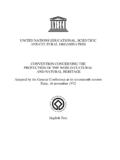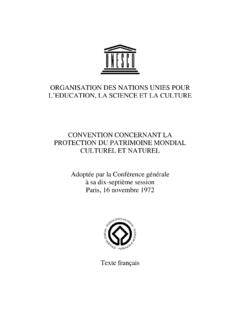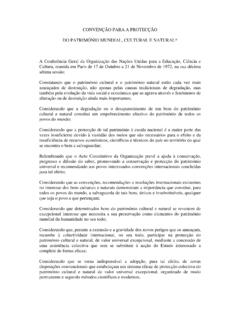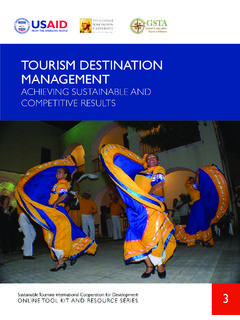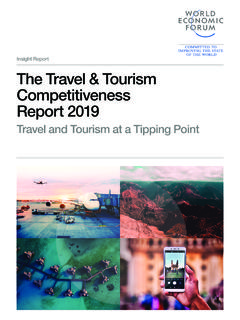Transcription of World Heritage Manuals 1
1 WH manual1- cover 31/10/02 14:40 Page 1. World Heritage Manuals World Heritage Manuals a Practical Manual for World Heritage Site Managers Managing Tourism at World Heritage Sites: Designed by RectoVerso Managing Tourism at World Heritage Sites: Cover printed on chlorine free paper; interior printed on recycled paper a Practical Manual for World Heritage Site Managers Manuals By Arthur Pedersen For more information contact: For more information contact: United Nations Environment Programme UNESCO World Heritage Centre Division of Technology, Industry and Economics Cover photo: Wo r l d H e r i t a g e Tour Mirabeau, 39-43 Quai Andr Citro n 7, place de Fontenoy 75739 Paris - Cedex 15, France 75352 Paris 07 SP France Tel. : 33 (0)1 44 37 14 50 Tel : 33 (0)1 45 68 18 76.
2 Fax : 33 (0)1 44 37 14 74 Fax : 33 (0)1 45 68 55 70. E-mail: E-mail : WH manual1-intro 31/10/02 14:02 Page 1. Managing Tourism at World Heritage Sites: a Practical Manual for World Heritage Site Managers By Arthur Pedersen WH manual1-intro 31/10/02 14:02 Page 2. Disclaimer The author is responsible for the choice and presentation of the facts contained in this publication and for the opinions expressed therein, which are not necessarily those of UNESCO and do not commit the Organization. The designation employed and the presentation of material throughout this publication do not imply the expression of any opinion whatsover on the part of UNESCO concerning the legal status of any country, territory, city or area or of its authorities, or concerning the delimitation of its frontiers or boundaries.
3 Published in 2002 by UNESCO World Heritage Centre 7, place de Fontenoy 75352 Paris 07 SP (France). Tel : (33) 01 45 68 18 76. Fax : (33) 01 45 68 55 70. E-mail : WH manual1-intro 31/10/02 14:02 Page 3. Foreword It is an inevitable destiny: the very reasons why a property is chosen for inscription on the World Heritage List are also the reasons why millions of tourists flock to those sites year after year. In fact, the belief that World Heritage sites belong to everyone and should be preserved for future generations is the very principle on which the World Heritage Convention is based. So how do we merge our convic- tions with our concerns over the impact of tourism on World Heritage sites? The answer is through sustainable tourism. Directing governments, site managers and visitors towards sustainable tourism practices is the only way to ensure the safekeeping of our World 's natural and cultural Heritage .
4 In 2002, the international community's virtually undivided attention was focused on tourism and its impact on our cultural and natural Heritage . It started with the United Nations declaration of 2002 as the Year for Cultural Heritage . Then in May, Qu bec City hosted the first ever World Ecotourism Summit, whose Declaration on the development of Ecotourism in the context of sustainable development was later delivered at the Johannesburg World Summit. In November, Heritage , tourism and development . is one of the focuses of the International Congress in Venice on the occasion of the 30th anniversary of the World Heritage Convention. Through the publication of this manual, we aim to harness this momen- tum by putting all of the ideas, theories and plans for sustainable tourism into action.
5 By learning to tread lightly on the earth, not only are we ensuring the future of World Heritage sites but also the future of tourism. It's a win-win situation for everyone involved: the site is better protect- ed and maintained, the tourist experiences a more pleasant visit, and the local economy is boosted as a result. Tourism is an important management issue at both natural and cultural World Heritage sites. It is an industry with well-known costs but also with the potential for aiding protection efforts. We recognize this potential and are convinced that by engaging, and by taking appropriate actions at the different levels of the sustainable tourism process, tourism can be managed to generate net site benefits. This manual outlines a process to guide site managers toward this end.
6 The first in a series of how to World Heritage Manuals , it is dedicated to the men and women who give their heart and soul everyday to protecting our World 's priceless treasures. Finally, I thank TEMA and UNEP for supporting the Centre's initiative to elaborate a user-friendly Manual for World Heritage Site Managers. Francesco Bandarin Director, UNESCO, World Heritage Centre Paris, France 3. WH manual1-intro 31/10/02 14:02 Page 5. Foreword I am proud to present this manual, another valuable contribution to the International Year of Ecotourism in 2002. Tourism is one of the World 's largest industries, with almost 700 million international tourists in 2002, and can become an essential tool in the challenge to overcome biodiversity losses and eradicate poverty, particularly in sensitive ecosystems and protected areas.
7 The basic fact is that a healthy social and natural environment is the first and most important asset for this global industry. It makes business sense for tourism stakeholders to be natural allies of sustainability. Protected areas, particularly World Heritage sites, are some of tourism's main attractions, and are subject to growing visitation. World Heritage sites are outstanding cultural and natural landscapes covering all kinds of ecosystems, which are carefully selected through a process resulting from a 1972 multilateral agreement involving 175 countries. Maintaining such sites requires adequate practices to guarantee environmentally sound management of the park and at the same time to ensure that local communities benefit from the park's existence.
8 The potential economic benefits that tourism can bring do not materialize without careful planning. Indeed, uncontrolled tourism development can have major negative impacts on these jewels of human- ity's Heritage . World Heritage site managers are often inadequately prepared to deal with the challenges of visitation and to negotiate with the complex tourism industry. Their background most often lies in forestry, public environmental management and biological sciences. Thus, concepts such as business management, marketing, and entrepreneurial risk management are still relatively new to many site man- agers. A practical, case-specific approach is used in the manual to explain these and other subjects, so that park managers can design and develop visitation according to the needs and limits of a site's master plans.
9 In 2002, UNEP, IUCN and the World Tourism Organization published a book entitled Sustainable Tourism in Protected Areas written by Dr. Paul Eagles of the World Commission on Protected Areas, with the contribution of many other international experts. This book aims at building a better understanding of issues related to tourism in protected areas and providing guidelines on how to address them. The pres- ent manual effectively complements the previous publication: it addresses the specific needs of World Heritage site managers and guides them through the visitor planning and management process. It is one more milestone in UNEP's long collaboration with UNESCO on improving benefits to protected areas through sustainable tourism. I am sure it will result in increased cooperation and partnerships among World Heritage site managers, the tourism industry, local communities, governments and travelers.
10 Jacqueline Aloisi de Larderel Assistant Executive Director Director, Division of Technology, Industry and Economics, United Nations Environment Programme 5. WH manual1-intro 31/10/02 14:02 Page 7. Preface It can be easy with all the other tourism Manuals around to ask why write another. This of course is a legitimate question that should be addressed by the author. The answer is quite simple: this manual comes out of a desire to see just what is being done in the field, trying to make sense of it all, comparing it to my own experience, and putting what I learned in a style of language hopefully everyone can understand. Having worked in visitor management and planning for many years, I wanted to know what we have discovered in using tourism as a tool to benefit conservation.
